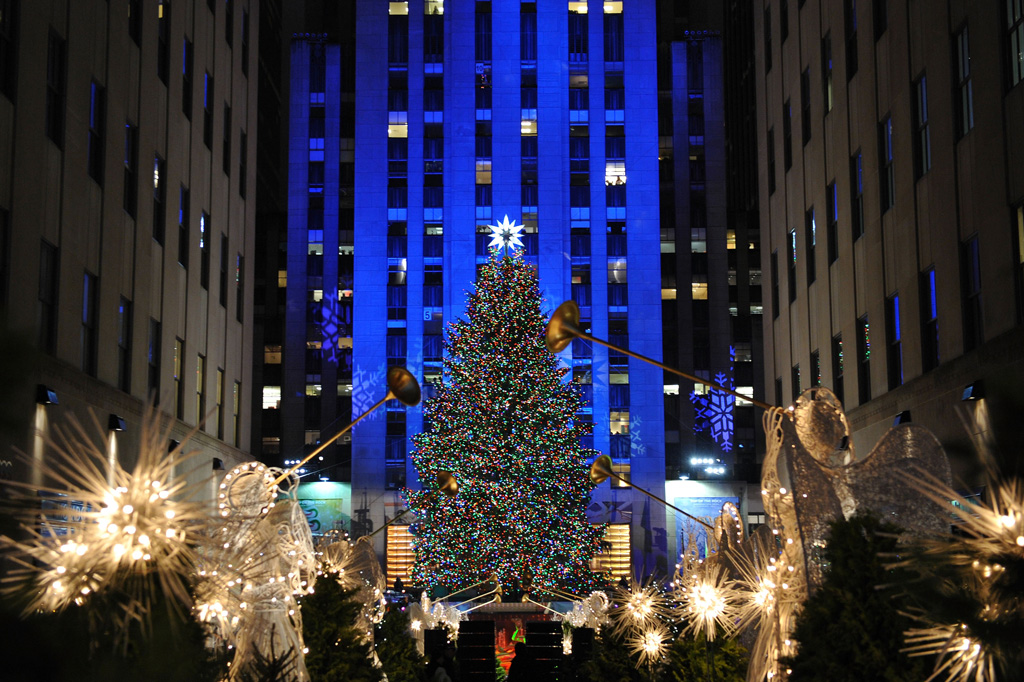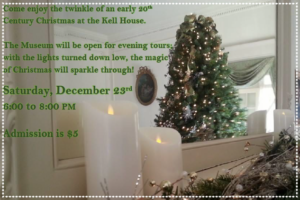CHRISTMAS TIPS
History of the Christmas Tree

By History.com
HOW IT ALL GOT STARTED
Long before the advent of Christianity, plants and trees that remained green all year had a special meaning for people in the winter. Just as people today decorate their homes during the festive season with pine, spruce, and fir trees, ancient peoples hung evergreen boughs over their doors and windows. In many countries it was believed that evergreens would keep away witches, ghosts, evil spirits, and illness.
In the Northern hemisphere, the shortest day and longest night of the year falls on December 21 or December 22 and is called the winter solstice. Many ancient people believed that the sun was a god and that winter came every year because the sun god had become sick and weak. They celebrated the solstice because it meant that at last the sun god would begin to get well. Evergreen boughs reminded them of all the green plants that would grow again when the sun god was strong and summer would return.
The ancient Egyptians worshipped a god called Ra, who had the head of a hawk and wore the sun as a blazing disk in his crown. At the solstice, when Ra began to recover from the illness, the Egyptians filled their homes with green palm rushes which symbolized for them the triumph of life over death.
Early Romans marked the solstice with a feast called the Saturnalia in honor of Saturn, the god of agriculture. The Romans knew that the solstice meant that soon farms and orchards would be green and fruitful. To mark the occasion, they decorated their homes and temples with evergreen boughs. In Northern Europe the mysterious Druids, the priests of the ancient Celts, also decorated their temples with evergreen boughs as a symbol of everlasting life. The fierce Vikingsin Scandinavia thought that evergreens were the special plant of the sun god, Balder.
Germany is credited with starting the Christmas tree tradition as we now know it in the 16th century when devout Christians brought decorated trees into their homes. Some built Christmas pyramids of wood and decorated them with evergreens and candles if wood was scarce. It is a widely held belief that Martin Luther, the 16th-century Protestant reformer, first added lighted candles to a tree. Walking toward his home one winter evening, composing a sermon, he was awed by the brilliance of stars twinkling amidst evergreens. To recapture the scene for his family, he erected a tree in the main room and wired its branches with lighted candles.
Most 19th-century Americans found Christmas trees an oddity. The first record of one being on display was in the 1830s by the German settlers of Pennsylvania, although trees had been a tradition in many German homes much earlier. The Pennsylvania German settlements had community trees as early as 1747. But, as late as the 1840s Christmas trees were seen as pagan symbols and not accepted by most Americans.
It is not surprising that, like many other festive Christmas customs, the tree was adopted so late in America. To the New England Puritans, Christmas was sacred. The pilgrims’s second governor, William Bradford, wrote that he tried hard to stamp out “pagan mockery” of the observance, penalizing any frivolity. The influential Oliver Cromwell preached against “the heathen traditions” of Christmas carols, decorated trees, and any joyful expression that desecrated “that sacred event.” In 1659, the General Court of Massachusetts enacted a law making any observance of December 25 (other than a church service) a penal offense; people were fined for hanging decorations. That stern solemnity continued until the 19th century, when the influx of German and Irish immigrants undermined the Puritan legacy.
In 1846, the popular royals, Queen Victoria and her German Prince, Albert, were sketched in the Illustrated London News standing with their children around a Christmas tree. Unlike the previous royal family, Victoria was very popular with her subjects, and what was done at court immediately became fashionable—not only in Britain, but with fashion-conscious East Coast American Society. The Christmas tree had arrived.
By the 1890s Christmas ornaments were arriving from Germany and Christmas tree popularity was on the rise around the U.S. It was noted that Europeans used small trees about four feet in height, while Americans liked their Christmas trees to reach from floor to ceiling.
The early 20th century saw Americans decorating their trees mainly with homemade ornaments, while the German-American sect continued to use apples, nuts, and marzipan cookies. Popcorn joined in after being dyed bright colors and interlaced with berries and nuts. Electricity brought about Christmas lights, making it possible for Christmas trees to glow for days on end. With this, Christmas trees began to appear in town squares across the country and having a Christmas tree in the home became an American tradition.
ROCKEFELLER CENTER CHRISTMAS TREE
The Rockefeller Center tree is located at Rockefeller Center, west of Fifth Avenue from 47th through 51st Streets in New York City.
The Rockefeller Center Christmas Tree dates back to the Depression Era days. The tallest tree displayed at Rockefeller Center came in 1948 and was a Norway Spruce that measured in at 100 feet tall and hailed from Killingworth,Connecticut.
The first tree at Rockefeller Center was placed in 1931. It was a small unadorned tree placed by construction workers at the center of the construction site. Two years later, another tree was placed there, this time with lights. These days, the giant Rockefeller Center tree is laden with over 25,000 Christmas lights.
CHRISTMAS TREES AROUND THE WORLD
Canada
German settlers migrated to Canada from the United States in the 1700s. They brought with them many of the things associated with Christmas we cherish today—Advent calendars, gingerbread houses, cookies—and Christmas trees. When Queen Victoria’s German husband, Prince Albert, put up a Christmas tree at Windsor Castle in 1848, the Christmas tree became a tradition throughout England, the United States, and Canada.
Mexico
In most Mexican homes the principal holiday adornment is el Nacimiento (Nativity scene). However, a decorated Christmas tree may be incorporated in the Nacimiento or set up elsewhere in the home. As purchase of a natural pine represents a luxury commodity to most Mexican families, the typical arbolito (little tree) is often an artificial one, a bare branch cut from a copal tree (Bursera microphylla) or some type of shrub collected from the countryside.
Britain
The Norway spruce is the traditional species used to decorate homes in Britain. The Norway spruce was a native species in the British Isles before the last Ice Age, and was reintroduced here before the 1500s.
Greenland
Christmas trees are imported, as no trees live this far north. They are decorated with candles and bright ornaments.
Guatemala
The Christmas tree has joined the “Nacimiento” (Nativity scene) as a popular ornament because of the large German population in Guatemala. Gifts are left under the tree on Christmas morning for the children. Parents and adults do not exchange gifts until New Year’s Day.
Brazil
Although Christmas falls during the summer in Brazil, sometimes pine trees are decorated with little pieces of cotton that represent falling snow.
Ireland
Christmas trees are bought anytime in December and decorated with colored lights, tinsel, and baubles. Some people favor the angel on top of the tree, others the star. The house is decorated with garlands, candles, holly, and ivy. Wreaths and mistletoe are hung on the door.
Sweden
Most people buy Christmas trees well before Christmas Eve, but it’s not common to take the tree inside and decorate it until just a few days before. Evergreen trees are decorated with stars, sunbursts, and snowflakes made from straw. Other decorations include colorful wooden animals and straw centerpieces.
Norway
Nowadays Norwegians often take a trip to the woods to select a Christmas tree, a trip that their grandfathers probably did not make. The Christmas tree was not introduced into Norway from Germany until the latter half of the 19th century; to the country districts it came even later. When Christmas Eve arrives, there is the decorating of the tree, usually done by the parents behind the closed doors of the living room, while the children wait with excitement outside. A Norwegian ritual known as “circling the Christmas tree” follows, where everyone joins hands to form a ring around the tree and then walk around it singing carols. Afterwards, gifts are distributed.
Ukraine
Celebrated on December 25th by Catholics and on January 7th by Orthodox Christians, Christmas is the most popular holiday in the Ukraine. During the Christmas season, which also includes New Year’s Day, people decorate fir trees and have parties.
Spain
A popular Christmas custom is Catalonia, a lucky strike game. A tree trunk is filled with goodies and children hit at the trunk trying to knock out the hazel nuts, almonds, toffee, and other treats.
Italy
In Italy, the presepio (manger or crib) represents in miniature the Holy Family in the stable and is the center of Christmas for families. Guests kneel before it and musicians sing before it. The presepio figures are usually hand-carved and very detailed in features and dress. The scene is often set out in the shape of a triangle. It provides the base of a pyramid-like structure called the ceppo. This is a wooden frame arranged to make a pyramid several feet high. Several tiers of thin shelves are supported by this frame. It is entirely decorated with colored paper, gilt pine cones, and miniature colored pennants. Small candles are fastened to the tapering sides. A star or small doll is hung at the apex of the triangular sides. The shelves above the manger scene have small gifts of fruit, candy, and presents. The ceppo is in the old Tree of Light tradition which became the Christmas tree in other countries. Some houses even have a ceppo for each child in the family.
Germany
Many Christmas traditions practiced around the world today started in Germany.
It has been long thought that Martin Luther began the tradition of bringing a fir tree into the home. According to one legend, late one evening Martin Luther was walking home through the woods and noticed how beautifully the stars shone through the trees. He wanted to share the beauty with his wife so he cut down a fir tree and took it home. Once inside he placed small lighted candles on the branches and said that it would be a symbol of the beautiful Christmas sky. Hence, the Christmas tree.
Another legend says that in the early 16th century, people in Germany combined two customs that had been practiced in different countries around the globe. The Paradise tree (a fir tree decorated with apples) represented the Tree of Knowledge in the Garden of Eden. The Christmas Light, a small, pyramid-like frame, usually decorated with glass balls, tinsel, and a candle on top, was a symbol of the birth of Christ as the Light of the World. Changing the tree’s apples to tinsel balls and cookies; and combining this new tree with the Light placed on top, the Germans created the tree that many of us know now.
Today, the Tannenbaum (Christmas tree) is traditionally decorated in secret with lights, tinsel, and ornaments by the mother and is lit and revealed on Christmas Eve with cookies, nuts, and gifts under its branches.
South Africa
Christmas is a summer holiday in South Africa. Although Christmas trees are not common, windows are often draped with sparkling cotton wool and tinsel.
Saudi Arabia
Christian Americans, Europeans, Indians, Filipinos, and others living here have to celebrate Christmas privately in their homes. Christmas lights are generally not tolerated. Most families place their Christmas trees somewhere inconspicuous.
Philippines
Fresh pine trees are too expensive for many Filipinos, so handmade trees in an array of colors and sizes are often used. Star lanterns, or parol, appear everywhere in December. They are made from bamboo sticks, covered with brightly colored rice paper or cellophane, and usually feature a tassel on each point. There is usually one in every window, each representing the Star of Bethlehem.
China
Of the small percentage of Chinese who do celebrate Christmas, most erect artificial trees decorated with spangles and paper chains, flowers, and lanterns. Christmas trees are called “trees of light.”
Japan
For most of the Japanese who celebrate Christmas, it’s purely a secular holiday devoted to the love of their children. Christmas trees are decorated with small toys, dolls, paper ornaments, gold paper fans and lanterns, and wind chimes. Miniature candles are also put among the tree branches. One of the most popular ornaments is the origami swan. Japanese children have exchanged thousands of folded paper “birds of peace” with young people all over the world as a pledge that war must not happen again.
CHRISTMAS TREE TRIVIA
Christmas trees have been sold commercially in the United States since about 1850.
In 1979, the National Christmas Tree was not lighted except for the top ornament. This was done in honor of the American hostages in Iran.
Between 1887-1933 a fishing schooner called the Christmas Ship would tie up at the Clark Street bridge and sell spruce trees from Michigan to Chicagoans.
The tallest living Christmas tree is believed to be the 122-foot, 91-year-old Douglas fir in the town of Woodinville, Washington.
The Rockefeller Center Christmas tree tradition began in 1933. Franklin Pierce, the 14th president, brought the Christmas tree tradition to the White House.
In 1923, President Calvin Coolidge started the National Christmas Tree Lighting Ceremony now held every year on the White House lawn.
Since 1966, the National Christmas Tree Association has given a Christmas tree to the President and first family.
Most Christmas trees are cut weeks before they get to a retail outlet.
In 1912, the first community Christmas tree in the United States was erected in New York City.
Christmas trees generally take 6-8 years to mature.
Christmas trees are grown in all 50 states including Hawaii and Alaska.
100,000 people are employed in the Christmas tree industry.
98 percent of all Christmas trees are grown on farms.
More than 1,000,000 acres of land have been planted with Christmas trees.
77 million Christmas trees are planted each year.
On average, over 2,000 Christmas trees are planted per acre.
You should never burn your Christmas tree in the fireplace. It can contribute to creosote buildup.
Other types of trees such as cherry and hawthorns were used as Christmas trees in the past.
Thomas Edison’s assistants came up with the idea of electric lights for Christmas trees.
In 1963, the National Christmas Tree was not lit until December 22nd because of a national 30-day period of mourning following the assassination of President Kennedy.
Teddy Roosevelt banned the Christmas tree from the White House for environmental reasons.
In the first week, a tree in your home will consume as much as a quart of water per day.
Tinsel was once banned by the government. Tinsel contained lead at one time, now it’s made of plastic.
In 1984, the National Christmas Tree was lit on December 13th with temperatures in the 70s, making it one of the warmest tree lightings in history.
34 to 36 million Christmas trees are produced each year and 95 percent are shipped or sold directly from Christmas tree farms.
California, Oregon, Michigan, Washington, Wisconsin, Pennsylvania, and North Carolina are the top Christmas tree producing states.
The best selling trees are Scotch Pine, Douglas Fir, Fraser Fir, Balsam Fir, and White Pine.
CHRISTMAS TIPS
Come see the Kell House decorated for the holidays
We have three ways for you to come see the Kell House decorated in all its Christmas finery this week before it’ll be closed until 2018!
Regular weekday tours will take place 10 a.m. to 3 p.m., Monday through Friday (closed Wednesday) from 10 a.m. to 3 p.m.
We will be part of Downtown’s Candlewalk on Thursday, December 21st, from 5 p.m. to 8 p.m. Come see our favorites Elves!
Or come enjoy the Kell House with a special Candelight tour on Saturday. December 23rd from 6 p.m. to 8 p.m. Admission is $5.
CHRISTMAS TIPS
Tips for less stressful holiday travel

As the holiday season is upon us, it can be a stressful time for many, including for those traveling to visit family and friends. Follow these tips below to help make your holiday travel less stressful. See your mid-week News for other tips, along with more holiday fun in each edition of The Bowie News in November.
Tips for less stressful holiday travel
Roadways, railways and skies tend to get busy come the holiday season, when millions of people across the globe travel to visit family and friends.
Wherever travelers are headed, be it across the country or across the world, they should realize that many other people are traveling as well. That can lead to traffic, long lines and other side effects associated with large crowds. But before travelers let the idea of challenging travel conditions deter them, they can consider certain ways to make the process of getting from point A to point B a bit more manageable.
Travel by car
Those traveling by automobile will have a few extra steps to take to ensure their trips go off with minimal disturbances. One of the more important steps is to ensure the vehicle is properly maintained prior to departing. Have the car checked by a mechanic and take care of any service appointments, such as oil changes or tire rotations.
Map out the route in advance and have an alternative plan if the route chosen proves to be too congested. One idea is to choose a scenic drive that may be a little longer but has less traffic. In addition, account for rest stops or points of interest that can break up the trip. Apps such as GasBuddy can help drivers find the cheapest gas or the cleanest bathrooms along their routes.
Bring along plenty of snacks so you can eat healthy and arenÕt forced to rely on foods you otherwise would not eat. This is particularly helpful with keeping kids satiated. Plan for a few treats along the way so that everyone traveling has an end goal, such as an ice cream or a souvenir.
Traveling by plane
One of the key things air travelers can do to make holiday traveling easier is to avoid peak travel dates. Whenever possible, avoid traveling the day right before the holiday, which tends be the busiest and most expensive. Remember, weekends tend to be more harried and expensive as well, particularly when the holidays fall in close proximity to a weekend.
Weather is a gamble in many regions of the world during the holiday season. Develop a contingency plan just in case foul weather delays or cancels flights. ItÕs much less stressful to put plan B into motion than it can be to rush around trying to make new, last-minute plans.
Always shop around for the best rates, but also the best atmosphere. It may be wiser to fly out of a smaller airport where crowds will be thinner and delays less frequent, or you may prefer a larger airport thatÕs closer to home and offers more amenities.
Another way to avoid delays is to pack minimally. Ship gifts and even travel essentials ahead to your destination, and only bring carry-on bags aboard the plane. This helps travelers sail through security checks and avoid the crowds at the luggage carousels.
Holiday travel requires planning, patience and having alternative plans in place so that everyone can make it home for the holidays. TF169407
CHRISTMAS TIPS
Christmas Trivia
-

 NEWS3 years ago
NEWS3 years ago2 hurt, 1 jailed after shooting incident north of Nocona
-

 NEWS2 years ago
NEWS2 years agoSuspect indicted, jailed in Tia Hutson murder
-

 NEWS2 years ago
NEWS2 years agoSO investigating possible murder/suicide
-

 NEWS2 years ago
NEWS2 years agoWreck takes the life of BHS teen, 16
-

 NEWS2 years ago
NEWS2 years agoMurder unsolved – 1 year later Tia Hutson’s family angry, frustrated with no arrest
-

 NEWS2 years ago
NEWS2 years agoSheriff’s office called out to infant’s death
-

 NEWS2 years ago
NEWS2 years agoBowie Police face three-hour standoff after possible domestic fight
-

 NEWS3 years ago
NEWS3 years agoDriver stopped by a man running into the street, robbed at knifepoint











